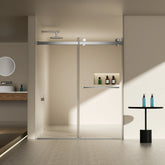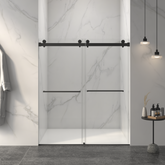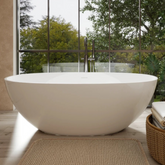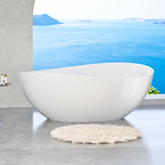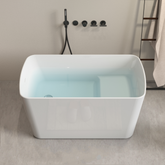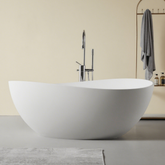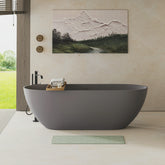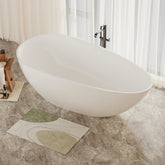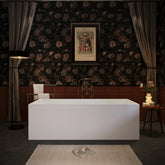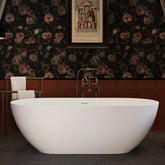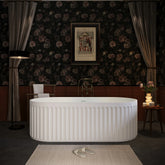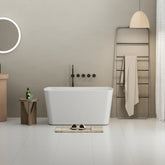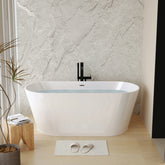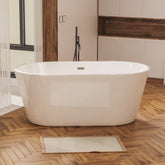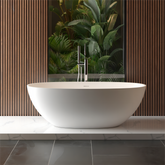Title: Freestanding vs. Built-In Bathtubs: Which Fits Your Style?
1. Introduction
When I started planning my bathroom remodel, I quickly realized that the bathtub isn’t just a functional piece—it’s the centerpiece of the entire space. Choosing the right bathtub style sets the tone for comfort, design, and even how practical the bathroom will feel day to day. Among all the options available, two stand out as the most popular: the freestanding bathtub and the built-in bathtub.
At first, I thought the choice would be simple, but the more I looked into it, the more I saw how much this decision could impact everything—from the flow of the room to how I actually enjoy my bath time. A freestanding tub makes a bold design statement and adds a touch of luxury, while a built-in tub is often more practical and space-saving. Each option has its own pros and cons, and it really comes down to lifestyle, bathroom layout, and personal taste.
In this article, I’ll compare freestanding vs. built-in bathtubs and share the key differences that can help you decide which one truly fits your style. Whether you’re aiming for a modern luxury look or a more efficient setup, understanding these two bathtub styles is the first step toward creating a bathroom you’ll love.

2. What Is a Freestanding Bathtub?
When I first came across the idea of a freestanding bathtub, I was drawn to how it instantly transformed the bathroom into a more luxurious and spa-like space. By definition, a freestanding tub is a bathtub that stands alone and is not attached to any walls or built into a structure. This makes it a statement piece, often becoming the visual centerpiece of the bathroom.
One of the key features of a freestanding bathtub is its flexibility in design. Unlike built-in tubs, which are often confined to corners or alcoves, freestanding tubs can be placed almost anywhere in the bathroom, as long as plumbing access is available. This opens up a world of creative layout possibilities and gives the room a sense of openness and elegance.
In terms of materials and designs, I noticed that freestanding tubs come in a wide variety. You’ll find options in classic cast iron, sleek acrylic, durable stone resin, and even modern composites. The shapes range from elegant oval and rectangular forms to more artistic, sculptural designs that double as decor. This variety means it’s easy to match the tub with your overall bathroom style, whether you prefer modern minimalism, rustic charm, or high-end luxury.
As for placement, freestanding bathtubs are often showcased in the center of the bathroom, near a large window, or on a raised platform to emphasize their visual appeal. Personally, I love how a freestanding tub can transform even a simple bathroom into something that feels like a retreat. It’s not just about taking a bath—it’s about creating a design statement that reflects your lifestyle.

3. What Is a Built-In Bathtub?
When I was exploring different bathtub options, I quickly realized that the built-in bathtub is one of the most common and practical choices for many homes. By definition, a built-in tub is installed against one or more walls and usually enclosed by a frame or surround. This setup makes it a more permanent fixture compared to a freestanding bathtub, and it often integrates seamlessly with the rest of the bathroom design.
The key features of a built-in bathtub are all about function and efficiency. Because it’s anchored into a specific spot, the built-in style allows for easier plumbing installation and often includes space for additional features like a shower combination or storage ledges along the wall. This makes it a highly practical option, especially for families or bathrooms with limited space.
In terms of designs, built-in bathtubs usually come in three main styles: alcove, drop-in, and corner tubs. Alcove tubs are the most common, fitted snugly between three walls with a shower often installed above. Drop-in tubs are placed into a framed deck, giving more flexibility in shape and style, while corner tubs are designed to maximize space in smaller bathrooms or add a unique visual touch.
From my perspective, built-in bathtubs are best suited for scenarios where space efficiency and practicality are top priorities. If your bathroom has a compact layout or you want the convenience of combining a bathtub and shower in one, a built-in option makes perfect sense. It might not have the dramatic design presence of a freestanding tub, but its practicality and cost-effectiveness make it a reliable choice for everyday living.

4. Freestanding Bathtubs: Pros and Cons
When I first considered installing a freestanding bathtub, I was captivated by how beautiful and elegant it looked. But as I dug deeper, I realized that while this type of bathtub offers many advantages, it also comes with certain challenges. Here’s what I learned about the pros and cons of choosing a freestanding design.
Pros of Freestanding Bathtubs
- Luxury Aesthetic: A freestanding tub instantly adds a sense of elegance and sophistication to the bathroom. It often feels like having a personal spa at home.
- Versatile Placement: Since the tub doesn’t need to be attached to a wall, I found that I could place it almost anywhere in the room—by a window, in the center, or even on a raised platform.
- Design Statement: Unlike built-in bathtubs, a freestanding tub stands out as a centerpiece. It makes a bold design statement and can completely change the atmosphere of the bathroom.
Cons of Freestanding Bathtubs
- Requires More Space: One thing I noticed is that freestanding bathtubs generally need more floor space, which makes them less ideal for smaller bathrooms.
- Higher Cost: These tubs often come at a higher price point, not only for the product itself but also for delivery and installation.
- Trickier Plumbing: Because they are not against a wall, the plumbing for a freestanding bathtub can be more complex. In some cases, this adds to the installation time and cost.
For me, the freestanding option was all about choosing between style and practicality. If you want your bathtub to be a luxurious focal point, this design is hard to beat. But if your bathroom space or budget is limited, you’ll need to weigh these factors carefully.

5. Built-In Bathtubs: Pros and Cons
When I was evaluating the idea of installing a built-in bathtub, I quickly realized that this style is one of the most common choices for good reason. It’s practical, efficient, and often easier to fit into a variety of bathroom layouts. Still, like any option, it comes with both benefits and drawbacks. Here’s how I see the pros and cons.
Pros of Built-In Bathtubs
- Space-Saving: Built-in bathtubs are perfect for smaller bathrooms since they can fit snugly into corners or alcoves. This makes them a great solution when floor space is limited.
- Practical: I appreciate that built-in tubs often double as showers, making them highly versatile. Plus, the surrounding walls or deck can provide extra ledges for toiletries and storage.
- Often More Affordable: Compared to a freestanding bathtub, built-in tubs are generally less expensive. Installation and plumbing are also simpler, which can help keep overall costs down.
Cons of Built-In Bathtubs
- Less Design Flexibility: Unlike freestanding tubs that can be placed almost anywhere, built-in bathtubs are restricted to specific layouts, usually against a wall or in an alcove.
- Harder to Replace: Because the tub is enclosed within a frame or tile surround, swapping it out later can be a major renovation project.
- Limited Visual Impact: While practical, a built-in bathtub doesn’t usually serve as a design centerpiece. It blends into the room rather than standing out as a statement feature.
For me, a built-in bathtub felt like the sensible choice if I wanted something reliable, space-efficient, and budget-friendly. However, if creating a bold design statement was my top priority, I knew a built-in style wouldn’t deliver the same impact as a freestanding tub.

6. Design Considerations: Which Matches Your Style?
When I was choosing between a freestanding bathtub and a built-in bathtub, I quickly realized that the decision wasn’t only about looks or cost—it was also about how the bathtub would fit into my lifestyle and the overall bathroom design. Here are the main factors I considered before making my choice.
Bathroom Size and Layout
Space was the first thing I looked at. A freestanding tub requires more open floor area, which works beautifully in larger bathrooms where you can let it shine as a centerpiece. On the other hand, if your bathroom is compact or has a specific layout, a built-in bathtub can make better use of limited space by fitting neatly into an alcove or corner.
Personal Lifestyle
I also asked myself how I actually use my bathtub. If I wanted long, relaxing soaks and a spa-like experience, the freestanding bathtub felt like the perfect fit. But if I needed something more practical—like combining a shower and tub for quick, everyday use—a built-in bathtub seemed far more convenient. Your lifestyle really shapes which option will serve you best.
Design Goals
Lastly, I thought about the style I wanted for my bathroom. A freestanding tub makes a bold design statement and is perfect for those chasing a modern luxury vibe. A built-in bathtub, however, fits better if you’re going for a minimalist or space-efficient design. Personally, I found it helpful to picture how each option would contribute to the overall mood and functionality of the room.
In the end, matching your bathtub choice with your bathroom size, lifestyle, and design goals ensures you don’t just buy a tub—you create a space that truly reflects your style and needs.

7. Cost & Installation Differences
When I compared a freestanding bathtub with a built-in bathtub, the biggest surprise was how much the costs and installation details could influence my decision. It’s not just about the price tag on the tub itself—it’s also about the work that goes into setting it up and keeping it in good condition over time.
General Price Ranges
From what I found, freestanding bathtubs usually sit at the higher end of the price spectrum. Their elegant designs and larger size often make them more expensive to purchase and deliver. Built-in bathtubs, on the other hand, are generally more affordable. They are mass-produced in standard sizes, which makes them a budget-friendly option without sacrificing quality.
Installation Complexity
Installation was another big factor for me. A freestanding bathtub often requires more complex plumbing since the pipes need to be routed through the floor, sometimes even reinforced with extra support. Flooring also has to be considered because these tubs can be quite heavy. Built-in bathtubs, however, are simpler to install. The plumbing is usually straightforward, and the tub’s frame provides stability, making the process faster and less labor-intensive.
Maintenance Factors
Maintenance is something I didn’t think much about at first, but it makes a big difference. A freestanding bathtub is easier to clean around since it’s exposed on all sides, but reaching behind or underneath it can sometimes be tricky depending on its placement. A built-in bathtub, with its enclosed structure, collects less dust around the base but may require more effort to maintain caulking, tiles, or grout over time. Both styles have upkeep considerations, so it really comes down to which trade-off works best for your routine.
For me, weighing the cost, installation, and maintenance helped me see beyond the initial design appeal. It made me think practically about which bathtub style would truly fit both my budget and long-term needs.

8. Freestanding vs. Built-In: A Side-by-Side Comparison Table
After weighing all the details about freestanding bathtubs and built-in bathtubs, I found it helpful to put everything into a simple side-by-side table. Seeing the pros, cons, and key features lined up made it much easier for me to decide which one matched my bathroom and lifestyle. Here’s a quick comparison guide you can use as well:
| Feature | Freestanding Bathtub | Built-In Bathtub |
|---|---|---|
| Design Impact | Luxury centerpiece; bold design statement | Blends into layout; less dramatic visually |
| Space Requirement | Needs more open floor space | Space-saving; fits in alcoves or corners |
| Price Range | Generally higher cost | Often more affordable |
| Installation | Complex plumbing and floor support | Simpler and faster installation |
| Maintenance | Easy to clean around, but harder behind/underneath | Easier day-to-day use; upkeep needed for caulking or tiles |
| Best For | Large bathrooms, luxury designs, long soaks | Compact layouts, practical everyday use |
Looking at this chart, I could clearly see the trade-offs between each option. If I wanted a statement piece for a spacious bathroom, the freestanding bathtub was the winner. But if I needed something more space-efficient and cost-effective, the built-in bathtub checked all the boxes.

9. How to Decide: Key Questions to Ask Yourself
After exploring the differences between a freestanding bathtub and a built-in bathtub, I realized that making the right choice comes down to asking myself a few key questions. Here’s what helped me clarify which option truly fit my bathroom and lifestyle.
Do I Have Enough Bathroom Space?
The first question I asked was about the size of my bathroom. Freestanding bathtubs look amazing but require ample floor space to make an impact. If your bathroom is small or has awkward corners, a built-in bathtub may be a smarter, more efficient choice. Assessing your space upfront helped me avoid a layout that would feel cramped.
Do I Prioritize Style or Practicality?
Next, I considered what mattered most to me: style or practicality. A freestanding tub is perfect if you want a luxurious centerpiece and are willing to invest in a dramatic design. On the other hand, a built-in bathtub offers practicality, often doubling as a shower and providing extra storage options. Identifying my priorities made it easier to narrow down the options.
What’s My Budget and Installation Plan?
Finally, I evaluated my budget and installation plan. Freestanding bathtubs tend to be more expensive, both in terms of purchase and installation. Built-in tubs are generally more affordable and easier to install, especially if you’re working with standard plumbing and tile configurations. Understanding the financial and logistical aspects helped me choose a bathtub that aligned with both my design goals and my wallet.
Asking myself these questions clarified the trade-offs between freestanding and built-in bathtubs, and ultimately guided me toward a choice that balanced aesthetics, functionality, and budget.

10. Conclusion
After going through all the details about freestanding bathtubs and built-in bathtubs, I’ve realized that both options have their unique strengths. Freestanding tubs offer a luxurious aesthetic and make a bold design statement, while built-in tubs provide practicality, space efficiency, and often a more budget-friendly solution.
For me, the key takeaway is that there isn’t a one-size-fits-all answer. The best choice depends on your bathroom size, personal lifestyle, design goals, and budget. Whether you lean toward the dramatic elegance of a freestanding tub or the practical versatility of a built-in bathtub, understanding these differences ensures that your selection will enhance both the function and the style of your space.
Ultimately, taking the time to assess your needs and preferences made me confident in my decision. I encourage you to consider how you actually use your bathroom, the layout you have, and the aesthetic you want to achieve before choosing between a freestanding or built-in bathtub. That way, you’ll end up with a bathtub that’s not only beautiful but also perfectly suited to your lifestyle.
Featured Products
AISU 65" Freestanding Solid Surface Bathtub, Handcrafted Stone Resin with Overflow and Pop-up Drain, Glossy White
- $1,585.43
- $1,585.43
- Prix unitaire
- / par
AISU 63" Freestanding Solid Surface Bathtub, Engineered Stone Resin with Overflow and Pop-up Drain for Contemporary Bathroom, Glossy White
- $1,700.09
- $1,700.09
- Prix unitaire
- / par
AISU 49” Acrylic Freestanding Soaking Bathtub, Square-shape Japanese Soaking Hot Tub, Glossy White
- $762.99
- $762.99
- Prix unitaire
- / par
AISU 63" Luxury Freestanding Solid Surface Bathtub, Matte White
- $1,700.09
- $1,700.09
- Prix unitaire
- / par
Baignoire îlot AISU 65" en résine de pierre, avec trop-plein et bonde escamotable, blanc mat
- $1,716.81
- $1,716.81
- Prix unitaire
- / par
Baignoire autoportante AISU en résine de pierre, avec trop-plein et bonde escamotable, pour salle de bain contemporaine, gris mat
- Depuis $1,645.26
- Depuis $1,645.26
- Prix unitaire
- / par
Baignoire îlot AISU 59 pouces en résine de pierre, baignoire îlot de luxe fabriquée à la main avec trop-plein et bonde escamotable, blanc brillant
- $1,506.75
- $1,506.75
- Prix unitaire
- / par
Baignoire îlot AISU 67" en résine de pierre, avec trop-plein et bonde escamotable, blanc mat
- $1,801.71
- $1,801.71
- Prix unitaire
- / par
Baignoire autoportante AISU en résine de pierre reconstituée, baignoire autoportante de luxe avec trop-plein et bonde escamotable pour salle de bain contemporaine, blanc mat
- Depuis $1,533.26
- Depuis $1,533.26
- Prix unitaire
- / par
Baignoire autoportante AISU 67 po en résine synthétique, baignoire autoportante de luxe avec trop-plein et bonde escamotable, certifiée cUPC, blanc mat
- $1,944.21
- $1,944.21
- Prix unitaire
- / par
Baignoire autoportante en acrylique AISU 49'', bain à remous japonais carré, trop-plein chromé et vidange rapide
- Depuis $771.67
- Depuis $771.67
- Prix unitaire
- / par
-
Blanc brillant
-
Noir brillant
Baignoire îlot en acrylique AISU, baignoire autonome, acrylique blanc brillant, bonde chromée à robinet, certifiée cUPC
- Depuis $743.66
- Depuis $743.66
- Prix unitaire
- / par
Baignoire autoportante en acrylique blanc brillant de 60 po avec bonde chromée à robinet et trop-plein à fentes classique
- $1,029.19
- $1,029.19
- Prix unitaire
- / par
Baignoire autoportante en surface solide de 65 po avec trop-plein et bonde escamotable, blanc mat
- $1,584.73
- $1,584.73
- Prix unitaire
- / par
